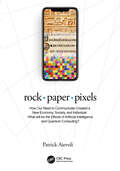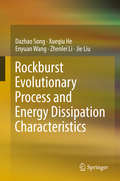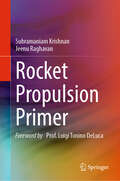- Table View
- List View
Rock • Paper • Pixels: How Our Need to Communicate Created a New Economy, Society, and Individual: What will be the Effects of Artificial Intelligence and Quantum Computing?
by Patrick AievoliThe purpose of this book is to avail faculty, and students of the many different innovations, events, effects, and back-stories equated with the advent of this new era of communications and its impact on our world. At our core we are a species that needs to communicate and to find a way to properly represent those messages. Since the beginning of recorded history mankind has always attempted to communicate and to keep track of its endeavors and accomplishments. Now by using interaction design and modern digital media it has become possible to present “our story” through many current and evocative platforms.As each generation comes of age this new method is being utilized in all areas of their communication choices. These new generations desire their communication at a different rate than its predecessors. They want their information Internet ready and interactive. They are involved in the immediate and that choice is not going away. Interactive media is here to stay and has new rules and new effects. It is changing our economies, our societies and especially us - as individuals.The main goal of this book is to help you see how it started, where it is going and how to be on the right side of this transformation. How to take your first steps in that new direction and how to understand the effects of this new form of communication while being aware of its abilities and its dangers.As a friend once said, “no matter how thin you slice it there are always two sides.”
Rock-Filled Concrete Dam (Hydroscience and Engineering)
by Feng Jin Duruo HuangThis book provides a timely review on recent advancements in rock-filled concrete dam: a new type of dam originated from Tsinghua University in China. It covers historical overview of the development, filling process of high performance self-compacting concrete, mechanical and physical properties of rock-filled concrete, design of rock-filled concrete gravity dams and arch dams, as well as construction and quality control specifications. The book is intended for researchers, practicing engineers and graduate students who are interested in fundamental research and engineering design principles of rock-filled concrete dams. Successful insights gained from more than 120 rock-filled concrete dams completed or under construction in China are presented in this book, which can be useful references for all readers.
Rockburst Evolutionary Process and Energy Dissipation Characteristics
by Jie Liu Dazhao Song Xueqiu He Enyuan Wang Zhenlei LiThis book investigates the evolution process of rockburst based on the energy dissipation theory and proposes appropriate active prevention and control technologies. It discusses the electromagnetic radiation (EMR) generated by coal rock fractures as a measurement of the amount of dissipated energy, and the use of EMR to experimentally observe the time domain characteristics of energy dissipation during coal rock failure processes. It then proposes the concept of the rockburst activity domain system (RADS), establishes a dynamic pressure model of rockburst, and describes the energy criterion for rockburst instability. Lastly, it presents two waterjet cutting-based cases of pressure relief and rockburst prevention. The book serves as a reference resource for mine safety workers, engineering technicians, scientists, graduate students and undergraduates engaged in research on dynamic hazards such as rockburst..
Rockburst in Extra-Thick Coal Seam Mining: Mechanism and Prevention
by Sitao Zhu Fuxing Jiang Xiufeng Zhang Jinhai LiuThis book provides a detailed introduction to the mechanism of rockburst in extremely thick coal seam mining and explores the mechanical mechanism on why the critical depth of rockburst in extremely thick coal seam mining is significantly smaller than that in thin to thick coal seams, it also proposes targeted monitoring, warning, and treatment technologies. The prevention and control of coal mine rockburst is a global problem, attracting engineers and scientists from various disciplines such as mining, geology, geophysics, and civil engineering to conduct research. This book provides multiple case studies of rockburst accidents in mining of ultra-thick coal seams and provides a detailed analysis of the mechanisms and treatment technologies of each rockburst accident. It aims at graduate students, researchers, and on-site engineers who are interested in the mechanism of rockburst occurrence, monitoring, early warning, and treatment technology. The translation was done with the help of artificial intelligence. The present version has been revised technically and linguistically by the authors in collaboration with a professional translator.
Rockbursts and Seismicity in Mines 93: Proceedings of the 3rd international symposium, Kingston, Ontario, 16-18 August 1993
by R. Paul YoungThese proceedings include the latest developments in research and practice in the area of mining-induced seismicity. Three themes are explored: strong ground motion and rockburst hazard; mechanics of seismic events and stochastic methods; and monitoring of seismicity and geomechanical modelling.
Rockbursts in Coal Mines and Their Prevention
by Gerhard BraeunerThe preventive methods described have proved highly effective. They comprise laying out the workings in such a way as to minimize dangerous concentrations of ground stresses, and early elimination by means of blasting, drilling, or water infusion. An account of these methods as applied in German coal mines, the deepest in the world. Contents: Rockbursts & similar phenomena; Conditions of occurrence; Influence of rock stress; Bursting & nonbursting coal; Long-term prevention; Direct prevention; Borehole patterns for direct prevention; Destressing methods; Case histories.
Rocket (How It's Built)
by Elise WallaceKids are fascinated by how things are constructed, especially big things!This brand-new STEM (science, technology, engineering, and mathematics) series will take readers on visits to various work sites so they can see exactly How It’s Built! Kids will follow along as a small group of fictional characters get to find out exactly what it takes to build things that they probably see all the time, like bridges, houses, boats, and cars, to things that they might dream of being inside, like skyscrapers and rockets.
Rocket Beams, Lunar Dreams
by Chiara ColombiThe follow-up to Rocket Ship, Solo Trip that is sure to delight fans of Goodnight, Goodnight, Construction Site and explores the complicated emotions around building friendships and overcoming disappointment; featuring art from New York Times bestselling illustrator Scott Magoon!"Rocket ship. Lunar trip.Such excitement on the strip.Launchpad's ready. Clouds, at bay.She's going to the moon today!"After embarking on her first solo mission to place a satellite into orbit, Rocket is back, and she&’s headed on a lunar expedition! But this time she&’s not going alone. Instead of exploring, Rocket&’s mission is to drop off the spacecraft, Lander, and then return to Earth while Lander investigates the Moon's surface.Rocket can&’t seem to muster up any friendly words on their journey into orbit—the Moon is big! Why can&’t they share?! But when she learns that Lander is afraid of heights and needs a helping hand, Rocket decides to put aside her disappointment and help Lander accomplish his goal.With delightful rhyming stanzas and pictures by New York Times bestselling illustrator Scott Magoon, Rocket Beams, Lunar Dreams explores the complicated emotions around overcoming fears, forging friendships, and making peace with the fact that things don't always turn out as expected.
Rocket Billionaires: Elon Musk, Jeff Bezos, and the New Space Race
by Tim FernholzThis &“smart analysis of the New Space sector&” goes inside the rapid rise and dramatic rivalry of private space companies SpaceX and Blue Origin (The New York Times Book Review). For the outsize personalities staking their fortunes on spaceships, the new race to explore space could be a dead end, a lucrative opportunity—or the key to humanity&’s survival. Rocket Billionaires shines a light on Elon Musk and Jeff Bezos as they attempt to make history, reinvent the space economy, and feed their own egos. Beyond these two towering figures, Tim Fernholz introduces a supporting cast of equally fascinating entrepreneurs, from the irrepressible British mogul Richard Branson to the satellite internet visionary Greg Wyler. Fernholz&’s fly‑on‑the‑wall reporting captures an industry in the midst of disruption. While NASA seeks to preserve its ambitious space program, traditional aerospace firms like Boeing and Lockheed Martin scramble to adapt to new competitors, lobbyists tussle over public funds, and lawmakers try to prevent this new space race from sparking global conflict. It&’s a high‑stakes marathon that Fernholz recounts with expert analysis and revealing detail. Featured on NPR and PBS&’s SciTech Now, and in Fast Company, Forbes, and the Wall Street Journal
Rocket Dreams: Musk, Bezos, and the Inside Story of the New, Trillion-Dollar Space Race
by Christian Davenport&“Thrilling . . . an important tale of how American ingenuity and entrepreneurial spirit is creating a new type of space age.&”—Walter Isaacson, New York Times bestselling author of Elon MuskMusk vs. Bezos. China vs. the United States. The government vs. the private sector.Welcome to the rivalries and alliances defining the New Space Age. At stake? Trillions of dollars, national prestige, and a place in the history books.&“A fine piece of reporting; historians will be able to use this first draft of rocket history to craft deeper analyses of our first real steps as a space-faring society.&”—The New York TimesMoon landings and space walks once captivated the public&’s attention. But, in recent decades, the U.S. space enterprise has felt moribund. Now, that&’s finally about to change.A fleet of powerful new rockets is poised to take humans into the cosmos more than ever before. A lunar land rush has sparked a geopolitical competition among nations. And the world&’s two richest men have engaged in escalating brinkmanship, as NASA and the U.S. government embraces Silicon Valley innovation to jump-start the nation&’s ambitions.Space has entered a golden age, and this is just the beginning. In this gripping work, award-winning Washington Post writer Christian Davenport chronicles the mad scramble to shape humanity&’s off-planet future. He takes readers behind the scenes at NASA and the Pentagon as China&’s aggressive moon mining plans raise alarms, onto the sprawling Cape Canaveral factory where Blue Origin is working toward Amazon-style lunar deliveries, and onto SpaceX launch pads as Musk&’s engineers log 100-hour weeks—leaving veteran astronauts marveling that they&’re now operating &“flying iPhones.&” What will happen as human ambition outpaces governmental regulation? Which country will win the race back to the moon? Was Donald Trump&’s much-derided creation of the Space Force a surprising act of foresight, and will the U.S. finally make a real push to the moon and eventually toward Mars?Masterfully paced, rigorously reported, and vividly told, Rocket Dreams offers a riveting, fly-on-the-wall account of the grit-fueled global battle to push humankind further into the cosmos—revealing that the science fiction dreams of the last century may soon become our reality.
Rocket Girl: The Story of Mary Sherman Morgan, America's First Female Rocket Scientist
by George D. MorganLIKE THE FEMALE SCIENTISTS PORTRAYED IN HIDDEN FIGURES, MARY SHERMAN MORGAN WAS ANOTHERUNSUNG HEROINE OF THE SPACE AGE-NOWHER STORY IS FINALLY TOLD. This is the extraordinary true story of America's first female rocket scientist. Told by her son, it describes Mary Sherman Morgan's crucial contribution to launching America's first satellite and the author's labyrinthine journey to uncover his mother's lost legacy--one buried deep under a lifetime of secrets political, technological, and personal. In 1938, a young German rocket enthusiast named Wernher von Braun had dreams of building a rocket that could fly him to the moon. In Ray, North Dakota, a young farm girl named Mary Sherman was attending high school. In an age when girls rarely dreamed of a career in science, Mary wanted to be a chemist. A decade later the dreams of these two disparate individuals would coalesce in ways neither could have imagined. World War II and the Cold War space race with the Russians changed the fates of both von Braun and Mary Sherman Morgan. When von Braun and other top engineers could not find a solution to the repeated failures that plagued the nascent US rocket program, North American Aviation, where Sherman Morgan then worked, was given the challenge. Recognizing her talent for chemistry, company management turned the assignment over to young Mary. In the end, America succeeded in launching rockets into space, but only because of the joint efforts of the brilliant farm girl from North Dakota and the famous German scientist. While von Braun went on to become a high-profile figure in NASA's manned space flight, Mary Sherman Morgan and her contributions fell into obscurity--until now.
Rocket Man: Robert H. Goddard and the Birth of the Space Age
by David A. ClaryThis is the definitive biography of Robert H. Goddard (1882-1945) who was the father of rocketry and space flight, launching the world's first liquid-fuel rockets and the first powered vehicles to break the sound barrier.
Rocket Man: Robert H. Goddard and the Birth of the Space Age
by David A. ClaryMore famous in his day than Einstein or Edison, the troubled, solitary genius Robert H. Goddard (1882-1945) was the American father of rocketry and space flight, launching the world's first liquid-fuel rockets and the first powered vehicles to break the sound barrier. Supported by Charles Lindbergh and Harry Guggenheim, through fiery, often explosive, experiments at Roswell, New Mexico, he invented the methods that carried men to the moon. Today, no rocket or jet plane can fly without using his inventions. Yet he is the "forgotten man" of the space age. His own government ignored his rocketry until the Germans demonstrated its principles in the V-2 missiles of World War II. The American government usurped his 214 patents, while suppressing his contributions in the name of national security, until it was forced to pay one million dollars for patent infringement. Goddard became famous again, monuments and medals raining upon his memory. But his renewed fame soon faded, and Goddard's pivotal role in launching the Space Age has been largely forgotten.
Rocket Man: The Mercury Adventure of John Glenn
by Ruth AshbyOn February 20, 1962, as millions of Americans waited anxiously, astronaut John Glenn blasted off in his rocket ship, Friendship 7, and became the first American to orbit the Earth.Although the risks of such a mission for Friendship 7 were well known, no one including Glenn knew the peril he was about to encounter in space. John Glenn was one of the Mercury 7 astronauts, the early pioneers of manned space flight. His historic flight followed years of intensive physical training and a devotion to a career in the exciting but risk-filled world of aviation.Ruth Ashby's dramatic story of John Glenn's near-disastrous mission in Friendship 7 also takes young readers through his small-town Ohio childhood, his extraordinary experiences as a fighter pilot in two wars, and his life as an astronaut in the prestigious and dangerous Mercury 7 program. The book concludes with Glenn's successful career as a US senator and his triumphant return to space in 1998 at the age of 77.
Rocket Men: The Epic Story of the First Men on the Moon
by Craig NelsonRestoring the Drama, Majesty, and Sheer Improbability of an American Triumph that has now come to be taken for granted, this is the complete, definitive, and thrilling story of one of the greatest achievements of humankind. Through interviews, 23,000 pages of NASA oral histories, and declassified CIA documents on the space race, Rocket Men presents a grippingly vivid narrative of the mission to the moon that re-creates moments from the quotidian to the scientific to the magical, and takes you on that magnificent twentieth-century pilgrimage, a voyage into the unknown motivated by politics, faith, science, and wonder that changed the course of history.
Rocket Propulsion (Cambridge Aerospace Series #47)
by Stephen D. Heister William E. Anderson Timothée L. Pourpoint R. Joseph CassadyA modern pedagogical treatment of the latest industry trends in rocket propulsion, developed from the authors' extensive experience in both industry and academia. Students are guided along a step-by-step journey through modern rocket propulsion, beginning with the historical context and an introduction to top-level performance measures, and progressing on to in-depth discussions of the chemical aspects of fluid flow combustion thermochemistry and chemical equilibrium, solid, liquid, and hybrid rocket propellants, mission requirements, and an overview of electric propulsion. With a wealth of homework problems (and a solutions manual for instructors online), real-life case studies and examples throughout, and an appendix detailing key numerical methods and links to additional online resources, this is a must-have guide for senior and first year graduate students looking to gain a thorough understanding of the topic along with practical tools that can be applied in industry.
Rocket Propulsion Elements
by Oscar Biblarz George P. SuttonTHE DEFINITIVE INTRODUCTION TO ROCKET PROPULSION THEORY AND APPLICATIONS The recent upsurge in global government and private spending and in space flight events has resulted in many novel applications of rocket propulsion technology. Rocket Propulsion Elements remains the definitive guide to the field, providing a comprehensive introduction to essential concepts and applications. Led by industry veteran George P. Sutton and by Professor Oscar Biblarz, this book provides interdisciplinary coverage including thermodynamics, aerodynamics, flight performance, propellant chemistry and more. This thoroughly revised ninth edition includes discussion and analysis of recent advances in the field, representing an authoritative reference for students and working engineers alike. In any engineering field, theory is only as useful as it is practical; this book emphasizes relevant real-world applications of fundamental concepts to link "thinking" and "doing". This book will help readers: Understand the physics of flight and the chemistry of propulsion Analyze liquid, solid, gas, and hybrid propellants, and the engines they fuel Consider high-temperature combustion, stability, and the principles of electric and chemical propulsion Dissect the workings of systems in common use around the world today Delve into the latest advances in materials, systems, propellants, and more Broad in scope, rich in detail, and clear in explanation, this seminal work provides an unparalleled foundation in aerospace engineering topics. Learning through the lens of modern applications untangles complex topics and helps students fully grasp the intricacies on a more intuitive level. Rocket Propulsion Elements, Ninth Edition merges information and utility building a solid foundation for innovation.
Rocket Propulsion Primer
by Subramaniam Krishnan Jeenu RaghavanThis textbook covers fundamentals of rocket propulsion such as history, classification, qualitative design, quantitative design of internal ballistics and rocket vehicle optimization. It is intended to be used as a textbook by the undergraduate/advanced undergraduate students of aerospace engineering. It further describes the classification of aerospace propulsion, two-phase flows, nozzle contour design, advanced nozzle concepts (plug and expansion deflection nozzles) and materials. It also deals with the optimization of multistage rocket vehicles and their trajectories with reference to the currently operational orbital launch vehicles. This textbook contains numerous end-of-chapter problems to aid in self-learning of the students. It will be highly useful for the aerospace and mechanical engineering students. This can also be used as a reference guide by the scientists and engineers working in the areas of aerospace engineering.
Rocket Racers (Tom Swift Young Inventor #4)
by Victor AppletonCAN TOM AVOID A ROCKET WRECKAGE DISASTER? Tom Swift isn't your average teenager--he's a science prodigy! And, his inventions always involve cutting edge technology. With the help of his best friends Bud and Yo, Tom tests his gadgets and runs into all sorts of adventures. From deep-sea diving and shark bites to outsmarting an antiscience terrorist group, Tom Swift, Young Inventor, will keep you on the edge of your seat!
Rocket Rivals (Makers Make It Work)
by Lisa HarkraderTying into the popular Makers Movement, Makers Make it Work is a series of fun easy-to-read stories that focus on problem-solving and hands-on action. With bright, eye-catching art and explanatory sidebars with additional information on the topic, these books show kids how to use their hands, their heads, their creativity, and their problem-solving skills to overcome every challenge facing them. Rocket Club is Erin's kind of club. All rockets. No glitter. Then she's paired with Lily, the glitteriest girl in the grade. Will their rocket go bust? With the Makers Make It Work series, any kid can be a Maker! Each book also includes an activity for young makers to try themselves. (Topic: Rockets)
Rocket Says Look Up! (Rocket Says...)
by Nathan BryonMeet Rocket--a plucky aspiring astronaut intent on getting her community to LOOK UP! from what they're doing and reach for the stars in this auspicious debut picture book. Honored as a Chicago Public Library 2019 Best of the Best Book!A comet will be visible tonight, and Rocket wants everyone to see it with her--even her big brother, Jamal, whose attention is usually trained on his phone or video games. Rocket's enthusiasm brings neighbors and family together to witness a once-in-a-lifetime sighting. Perfect for fans of Ada Twist, Scientist and Cece Loves Science--Rocket Says Look Up! will inspire readers of all ages to dream big as it models Rocket's passion for science and infectious curiosity.Author Nathan Bryon, an actor and screenwriter, and Dapo Adeola, a community-minded freelance illustrator, bring their fresh talents, passion, and enthusiasm to the picture book medium.
Rocket Science: From Fireworks to the Photon Drive
by Mark Denny Alan McFadzeanThis is a book about rocket science: what it is and what it does. From the earliest fireworks to nuclear-powered spacecraft, all you would ever want or need to know about the subject is here, along with a straightforward explanation of how, why and when things work—or sometimes don't. We begin with the history and workings of early terrestrial rocketry before moving onto the main subject of the book: how we get things into space and, on occasion, back again. Entirely math-free, the chapters weave together innumerable anecdotes, real-world examples, and easy walk-throughs to help readers break down the complex physics behind some of humankind’s most amazing feats. Neither a pure textbook nor a populist space travel tome, the book will educate, inform and above all entertain anyone intrigued by rocket science.
Rocket Ship, Solo Trip
by Chiara ColombiA delightful, rhyming picture book that is perfect for fans of Goodnight, Goodnight, Construction Site and captures all the excitement and nervousness of life's big firsts; art by New York Times bestselling illustrator, Scott Magoon!&“First time jitters? That&’s okay.Find one small step to lead the way.&”Rocket is embarking on her first solo mission. Her goal? Place a satellite into orbit to take pictures of the beautiful unknown. With a few words of encouragement from Ground Control, Rocket sparks ignition and blasts off to discover all the beauty of outer space. But when it&’s time for reentry, she wonders if she can do it alone. With Ground Control&’s parting words in mind, Rocket trusts that she knows exactly what to do. She returns home at hypersonic speed and excited for her future expeditions…maybe next time, to the moon.With delightful rhyming stanzas, and pictures by New York Times bestselling illustrator Scott Magoon, Rocket Ship, Solo Trip explores all the complicated emotions of big firsts and reminds readers that no matter how far they go, the ones they love are always close by.
Rocket-Triggered Lightning: The Development of Physical Process and Effect of Lightning Discharge
by Mi Zhou Jianguo Wang Li Cai Jinxin Cao Yadong FanThis book summarises the fruitful results of rocket-triggered lightning experiments conducted in Guangdong, China, in recent years, including data analysis and theoretical research. One of the main features of this book is to compare the differences between lightning strikes on overhead power lines and strikes on the ground. Starting from the technical background and experimental methods of rocket-triggered lightning, the book delves into the electric current, electric field, magnetic field, optical and acoustic characteristics of artificially triggered lightning. Proceeding progressively from basic to advanced levels, this book meets the needs of scientists at different levels of expertise. It will benefit researchers, engineers and graduate students working in the fields of lightning detection, lightning physics and lightning protection.
Rocketeers: How a Visionary Band of Business Leaders, Engineers, and Pilots is Boldly Privatizing Space
by Michael Belfiore“That this story is still unfolding makes it especially exciting to read. These men are still in their workshops, tinkering their way into orbit.” —David Gelles, FORBESOn June 21, 2004, SpaceShipOne, built by aircraft designer Burt Rutan, entered space and ushered in the commercial space age. Investment capital began to pour into the new commercial spaceflight industry. Richard Branson’s VirginGalactic plans to ferry space tourists out of the atmosphere. Las Vegas hotelier Robert Bigelow is developing the world’s first commercial space station (i.e., space hotel). These space entrepreneurs, including Microsoft cofounder Paul Allen and Amazon.com founder Jeff Bezos, now see space as the next big thing.In Rocketeers, Michael Belfiore goes behind the scenes of this nascent industry, capturing its wild-west, anything-goes flavor. Likening his research to “hanging out in the Wright brothers’ barn,” Belfiore offers an inspiring and entertaining look at the people who are not afraid to make their bold dreams a reality.“The commercial space race is heating up so fast you need a cheat sheet to keep track of all the billionaires and gamblers vying to be the first private entrepreneur to blast paying customers into orbit. [Belfiore] does a stellar job introducing an intriguing cast of characters.” —Mark Horowitz, Wired“The privatization of space travel is an essential step toward realizing our cosmic destiny. In his engaging, highly readable Rocketeers, Michael Belfiore tells the fascinating story of the entrepreneurs who have already made it happen.” —Buzz Aldrin“A riveting, you-are-there account of how this ragtag collection of innovative thinkers, brave pilots, and bold visionaries is—right now—launching one of the most exciting new industries in history. Belfiore’s eloquent writing and exhaustive reporting really bring this mysterious, secretive world to life.” —Eric Adams, Popular Science
























